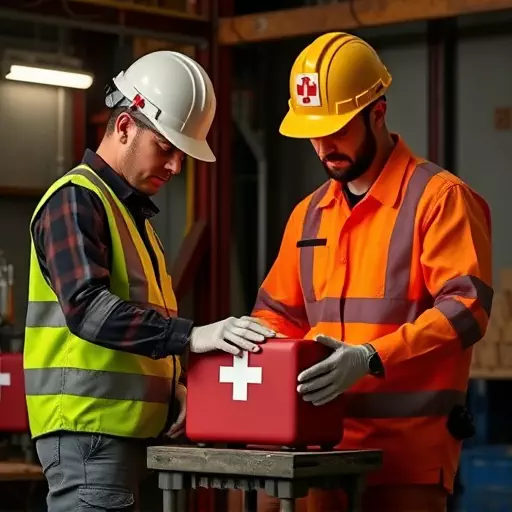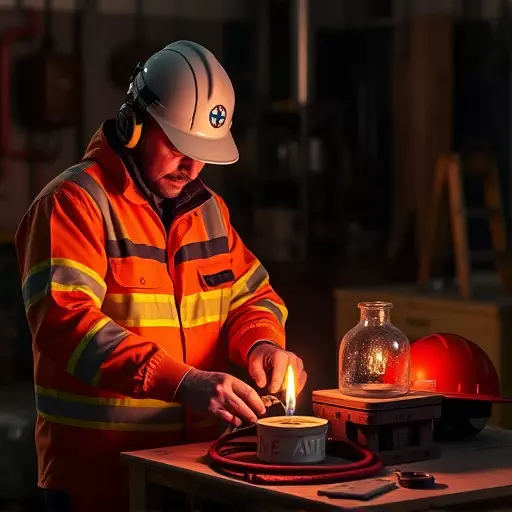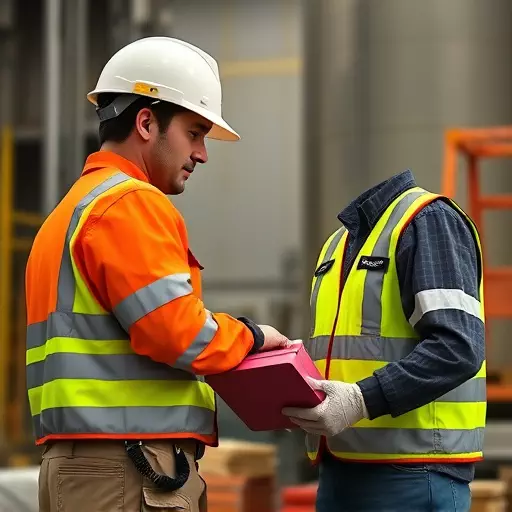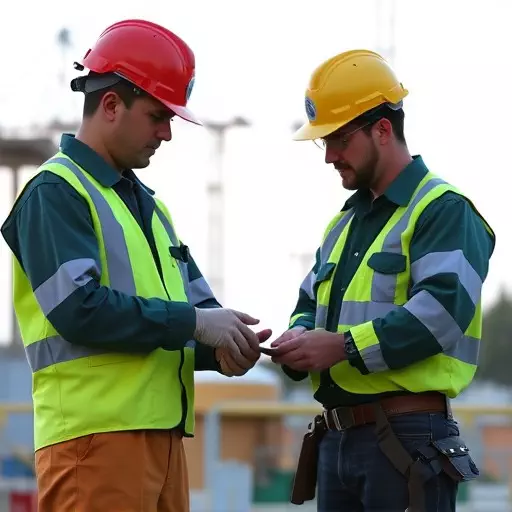CPR training for construction workers is mandated by OSHA due to the high-risk nature of construction sites. This training teaches basic first aid and CPR techniques to handle cardiac arrest, choking, and injuries. It empowers workers to respond quickly during emergencies, potentially saving lives. Compliance with OSHA requirements not only avoids legal issues but also fosters a safety culture within companies. Regular refresher courses are crucial for staying current with best practices. Construction firms can access grants from OSHA and other sources to fund these programs. Choosing the right CPR training provider ensures effective preparation for handling workplace hazards.
“In the high-risk environment of construction sites, equipping workers with essential life-saving skills is paramount. This article explores the critical need for CPR training for construction workers and first aid basics tailored to their unique challenges. We delve into OSHA requirements for CPR certification, highlighting the legal mandate and its impact on site safety.
Additionally, we uncover the numerous benefits of implementing CPR training programs in construction companies and provide an extensive guide to available grants for construction firms dedicated to funding such initiatives. Prepare to discover how these measures transform construction sites into safer spaces.”
- Understanding the Importance of CPR Training for Construction Workers
- First Aid Basics Every Construction Worker Should Know
- OSHA Requirements for CPR Certification: A Comprehensive Overview
- Benefits of Implementing CPR Training Programs in Construction Companies
- Types of Grants Available for Construction Firms to Fund CPR Education
- Choosing the Right CPR Training Provider: Tips and Considerations
- Success Stories: How CPR Grants Have Transformed Construction Sites
Understanding the Importance of CPR Training for Construction Workers

In the high-risk environment of construction sites, where accidents can occur at any moment, having well-trained personnel equipped with essential first aid skills is paramount. CPR (Cardiopulmonary Resuscitation) training for construction workers is not just a recommendation but an OSHA (Occupational Safety and Health Administration) requirement in many jurisdictions. It’s a crucial component of safety protocols designed to ensure the well-being of employees. Construction sites often present unique challenges, with workers potentially suffering from heart attacks, choking hazards due to dust or debris, or injuries leading to respiratory distress.
CPR training for construction workers goes beyond simply performing resuscitation; it encompasses the first aid basics necessary to manage various medical emergencies. This includes recognizing and responding to cardiac arrest, providing breathing assistance, and managing trauma. By equipping these workers with these skills, they can act swiftly in critical situations, potentially saving lives. Compliance with OSHA requirements for CPR certification not only ensures legal adherence but also fosters a culture of safety within construction companies.
First Aid Basics Every Construction Worker Should Know

Every construction worker should be equipped with basic first aid knowledge and CPR (Cardiopulmonary Resuscitation) training to handle emergencies on-site effectively. Construction sites pose unique risks, from heavy machinery accidents to falls and exposure to hazardous materials. Understanding how to respond promptly in critical situations can make a significant difference in saving lives.
CPR training for construction workers is essential, as it teaches them the life-saving skill of performing CPR when a colleague experiences cardiac arrest. The OSHA (Occupational Safety and Health Administration) has specific requirements for CPR certification, including regular renewals to ensure workers stay up-to-date with the latest techniques. Knowing how to perform CPR, along with basic first aid skills like treating wounds, handling burns, and managing bleeding, can help construction workers respond quickly during emergencies until professional medical services arrive.
OSHA Requirements for CPR Certification: A Comprehensive Overview

Construction sites present unique risks and challenges when it comes to safety. That’s why the Occupational Safety and Health Administration (OSHA) has established specific requirements for construction workers regarding CPR certification. These regulations aim to ensure that construction companies have well-trained personnel who can respond effectively in emergency situations, particularly those involving cardiac arrest.
According to OSHA, all construction workers must receive training in first aid basics, including cardiopulmonary resuscitation (CPR). The training should cover the recognition of various medical emergencies, the use of automated external defibrillators (AEDs), and, most crucially, CPR techniques tailored for construction site scenarios. Construction companies are responsible for providing this training to their employees regularly, ensuring they stay up-to-date with the latest standards and best practices in emergency care.
Benefits of Implementing CPR Training Programs in Construction Companies

Implementing CPR training programs in construction companies offers a multitude of benefits that extend far beyond compliance with OSHA requirements for cpr certification. By equipping construction workers with first aid basics, companies create safer work environments, mitigate liability risks, and demonstrate a commitment to employee welfare. Trained personnel can respond swiftly to medical emergencies, potentially saving lives and reducing the severity of injuries.
Moreover, these programs foster a culture of preparedness and mutual support among employees. Construction sites often present unique challenges, such as confined spaces and heavy machinery, where rapid intervention is crucial. Well-trained workers can recognize distress signals, administer effective CPR, and provide prompt first aid until professional medical help arrives. Such proactive measures not only enhance individual survival chances but also boost the overall morale and productivity of the workforce.
Types of Grants Available for Construction Firms to Fund CPR Education

Construction companies can access various grants to support and enhance their employees’ safety skills, with a particular focus on CPR training. These financial aids are designed to encourage businesses to invest in life-saving techniques, especially considering the unique risks faced by construction workers. One prominent source for such grants is the Occupational Safety and Health Administration (OSHA), which offers funding opportunities tailored to improving workplace safety. OSHA’s grant programs often include provisions for teaching first aid basics and CPR training for construction site personnel, ensuring they are equipped to handle emergency situations.
Grants can be used for comprehensive training programs that go beyond the basic requirements set by OSHA. Construction firms might seek funds for advanced courses, including those that teach advanced life support (ALS) techniques and specialized CPR training for specific scenarios. Additionally, some grants specifically target rural or minority communities where construction workers may face unique challenges in accessing emergency medical services. By leveraging these funding sources, construction companies can ensure their workforce is well-prepared to respond during emergencies, thereby reducing potential risks on the job site.
Choosing the Right CPR Training Provider: Tips and Considerations

When selecting a CPR training provider for your construction company, it’s crucial to consider several factors to ensure compliance with OSHA requirements and the well-being of your workforce. Start by evaluating their reputation and experience in delivering first aid basics tailored to construction workers’ unique needs. Look for providers with a proven track record of effective instruction and positive feedback from previous participants.
Additionally, confirm that the chosen provider adheres to OSHA standards and guidelines for CPR certification. The training should encompass not just cardiopulmonary resuscitation (CPR), but also advanced first aid techniques relevant to construction sites, including managing workplace injuries and responding to common hazards. Ensure the curriculum includes hands-on practice and evaluation to effectively equip your workers with the skills needed to handle emergency situations.
Success Stories: How CPR Grants Have Transformed Construction Sites

Construction sites are inherently dangerous environments, filled with potential hazards that demand quick thinking and skilled responses. This is where CPR training grants step in as game-changers, transforming these chaotic landscapes into havens of life-saving interventions. Many construction companies have harnessed the power of these grants to equip their workers with invaluable first aid skills, specifically focusing on CPR (Cardiopulmonary Resuscitation).
Through these initiatives, construction workers are no longer passive bystanders but active participants in ensuring their colleagues’ safety. The impact is profound: from saving lives during unexpected cardiac emergencies to fostering a culture of preparedness and mutual support. This shift aligns perfectly with OSHA’s (Occupational Safety and Health Administration) requirements for CPR certification, emphasizing the importance of proactive safety measures. Companies that prioritize these grants are setting new industry standards, proving that prioritizing worker well-being isn’t just ethical but also smart business practice.


